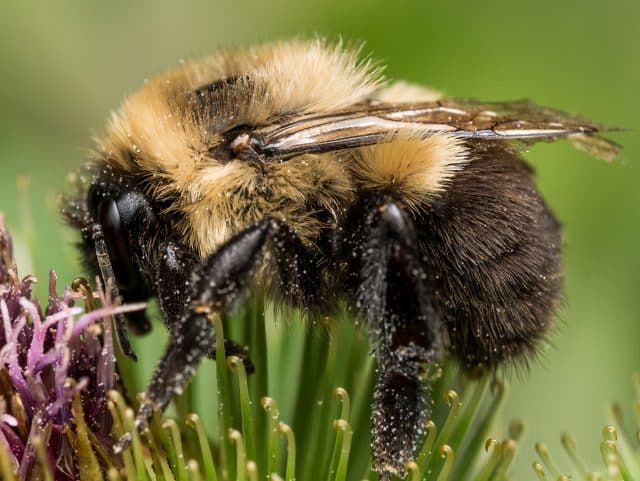How telematics and technology's 'hive minds' are saving the humble bee

You may well not be aware, but every year on July 10th the world observes Don’t Step On A Bee day. It’s a simple, sensible suggestion (!) but the true meaning behind it is to raise awareness of the fact that the fate of the humble bumblebee hangs in the balance.
Given the way we’ve anthropomorphized bees into cutesy little flying honey makers, you might be surprised to learn just how vital bees are to our ecosystems. In the human world, technology is underpinning our ecosystems, and telematics is the root technology empowering change and making us all bee-have a little more organized.
When is peak bee?
Whatever the kind of bee, almost 90 percent of wild plants and 75 percent of global crops need animals to pollinate them. When you extrapolate these figures, it means that approximately one in every three mouthfuls of our food have been dependent on bees as pollinators! To add to this, the global market value of honey is predicted to be worth $11.16 billion (€9.54 billion) by 2027 which is a tasty-looking market for beekeepers around the world!
Yet the health of the bee isn’t something we can or should take for granted. We reached 'peak bee' in 1946, as wax and honey became important staples during WW2. As recently as 2008, there were fears of a decline in the bee population, however communities, business and technology have combined to help create a resurgence, despite the ongoing threats bees face from parasites and disease, and climate change. And that’s before you factor in even more direct human behavior, such as hive theft, which technology, IoT and telematics are preventing.
Making sure bee hives can bee thrive
We worked with Geotrace SpA, whose client -- the Chilean-based Colmenares El Refugio -- actively produces honey. Technology has proved surprisingly deft at helping them overcome some significant challenges with their hives -- and support ongoing pollination and honey-making. The inability to control, nevermind even basically monitor, the temperature and humidity within their beehives, without affecting and ruining the microclimate within the hive, had already cause Colmenares El Refugio to lose 50 hives. Each hive cost $4000, and each loss caused a knock-on loss of $11,000 in future production from the hive. It constituted a significant expense, not to mention the intolerable cost in living bees.
Every major disease also resulted in the forced destruction of the affected bees, and constitutes a huge threat to the wider bee population. Added to this, the company had lost 100 bee hives at a cost of $23,000. It constituted a sizeable problem for Colmenares El Refugio -- and one that technology in the form of our GPS tracking and IoT platform Wialon was the answer to.
In this case it really was a 'hive mind' that came together to fix the problem -- by combining Wialon’s cloud-based data/monitoring system with Geotrace’s HiveTrace solution, to control the temperature and humidity of the hive. By embedding sensors within trackers in each hive, bees were then able to be kept thriving in the right conditions.
The devices we embedded also monitored beehives’ location and tracks any movement of them, to help safeguard from theft. It keeps beekeepers up-to-date, every 2 hours, via maps, charts and graphs on the Wialon platform.
It was a real group effort, with Geotrace first assessing the criteria of the problem, and planning the IoT solution that would best serve the bees’ needs. Then beekeeping specialists plotted and crafted the optimal climate for their bees, based on assessment of the conditions in different hives using the IoT devices. A testing phase, with walkthrough assessments of our trackers -- for connectivity and feedback -- led into the final stage of the project, which was testing in functional beehives to examine Wialon’s data collection and reception.
Applying this collective approach to a living animal environment, meant we had to create a fully non-invasive, and non-interfering IoT solution -- as the knock-on effects on the hives and their usual day-to-day could have been sizeable. So understanding the behavior of the hive and defining the best time, and even weather, for installation was an interesting task for all involved.
By using IoT and GPS to help the humble bumble, Colmenares El Refugio has since reported no thefts, increased savings and better conditions for their bees through potential disease and other bee-related epidemics. As work continues to preserve bee populations, we’re constantly looking for ways to improve the effectiveness of the solution -- currently at ways to actively count the bee population.
We’re proud of being a part of such a worthy solution, and of the innovative application of IoT, showing that where there are problems, tech-led IoT solutions can and are making a difference to parts of our lives you wouldn’t expect. Perhaps IoT can soon provide a solution that means no one can ever 'Step On A Bee', whatever the day!
Image credit: stevenellingson/depositphotos.com
Aliaksandr Kuushynau is Head of Wialon at Gurtam.
